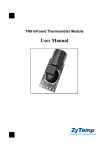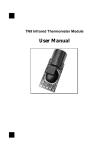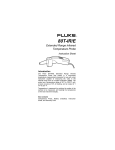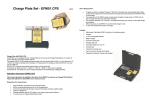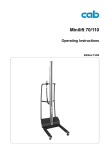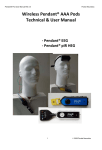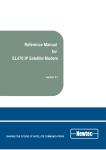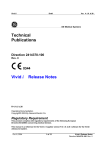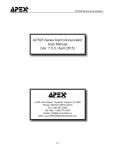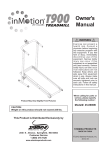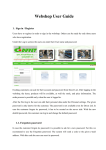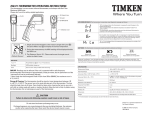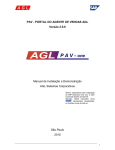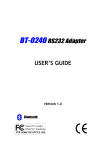Download User Manual
Transcript
TN905-05F Infrared Thermometer Module User Manual TN9 Infrared Thermometer Module Contents 1 GENERAL DESCRIPTION ..............................................................................................................................................3 EDITION JULY 2006 ..............................................................................................................................................................3 2 THEORY OF OPERATION .............................................................................................................................................4 2.1 PRINCIPLES OF OPERATION .............................................................................................................................................4 2.2 FEATURES OF DESIGN .....................................................................................................................................................5 2.3 FIELD OF VIEW................................................................................................................................................................6 2.4 EMISSIVITY .....................................................................................................................................................................7 3 SPECIFICATION...............................................................................................................................................................8 3.1 ABSOLUTE MAXIMUM RATING .......................................................................................................................................8 3.2 DC CHARACTERISTICS ....................................................................................................................................................8 3.3 MEASUREMENT SPECIFICATION ......................................................................................................................................9 3.4 PIN ASSIGNMENT OF TN0; TN9 ....................................................................................................................................10 4 SERIAL OUTPUT............................................................................................................................................................11 4.1 TYPICAL DIAGRAM .......................................................................................................................................................11 4.2 TIMING OF SPI ..............................................................................................................................................................12 4.2.1 Format of Message ...............................................................................................................................................13 4.2.2 Example ................................................................................................................................................................13 4.2.3 How to modify Emissivity? (How to write Emissivity into EEPROM)..................................................................14 5 INTERFACE DEMO BOARD: HUB-D.........................................................................................................................15 6 INTERFACE PROGRAM FOR PC ...............................................................................................................................16 http://www.ZyTemp.com REV. 12/31/2013 TN9 Infrared Thermometer Module 1 General Description This document describes the user guide of TNm Series (TN0; TN9). Edition July 2006 Copyright: All right reserved. Reproduction in any manner, in whole or in part is straightly prohibited without written permission of ZyTem.com. This information contained in this document is subject to change without notice. Limited Warranty: This data sheet contains information specific to products manufactured at the time of its publication, Contents herein do not constitute a warranty. Trademark Acknowledgements: All trademarks are the property of their respective owners. http://www.ZyTemp.com REV. 12/31/2013 TN9 Infrared Thermometer Module 2 Theory of Operation 2.1 Principles of Operation Fig 1. the Infrared Radiation Spectreum Infrared, just like any light ray, is an Electromagnetic Radiation, with lower frequency (or longer wavelength) than visual light. Anything above absolute zero (-273.15 degrees Celsius or 0 degrees Kelvin), radiates in the infrared. Even ice cube, snow, your refrigerator emit infrared. The Stefan-Boltzmann Law, where the total radiation energy is proportional to the fourth power of the absolute temperature and Wien Displacement Law, the product of the peak wavelength and the temperature is found to be a constant, are implemented in the TNm infrared thermometer module. The infrared radiation of measure target is collected by a infrared mirror through a IR filter of 5 or 8um cut in frequency to the infrared thermopile detector. The detector signal will be amplified and digitalize by the low noise and high linearity OP and AD convertor. The ambient temperature sensor( usually included in the same package as the thermopile detector ) is set in the space near the optical system to detect the fast change of the ambient temperature. The signal processing section receives the signals from these temperature sensors to calculate the target surface temperature by a mathematical algorithm. http://www.ZyTemp.com REV. 12/31/2013 TN9 Infrared Thermometer Module 2.2 Features of Design The TNm infrared thermometer module is specially designed for a high sensitivity, high accuracy, low noise and low power consumption. A number of design features contribute to the performance: MEMS thermopile detector and a high accurate ambient temperature compensation technics care used for the TNm infrared thermometer module. ZyTemp has developed a proprietary Infrared-System-On-Chip device that integrates all hardware items onto one IC. Using this innovative SoC technology, TNm infrared thermometer module has become a highly affordable and compact product. ZyTemp's products can faithfully withstand a thermal shock of 10degC/18degF. Our products are adept in maintaining accuracies under widely changing environmental conditions. For example, the errors from environmental changes of older IRTs can reach 1.6degC, requiring up to 30 minutes to stabilize, while ZyTemp's TNm error differential is only 0.7degC, needing only 7 minutes to restabilize. TNm products operate from a 3 Volt power supply, while many other older IRTs still require a 9 Volt supply. ZyTemp has maintained a NIST or National Measurement Laboratory traceable Temperature Primary Standard. All the TNm products are calibrated under traceable infrared standard sources. The calibration data and serial number are saved in a EEPROM on the module. http://www.ZyTemp.com REV. 12/31/2013 TN9 Infrared Thermometer Module 2.3 Field of View What is D:S = 5:1 This device has a D:S = 5:1 Distance : Spot = 5:1 Fig 2. Field of View When the Distance is 10 inch, then the measurement spot size is 2 inch. When the Distance is 20 inch, then the measurement spot size is 4 inch. In other words, the FOV(Field of View) is 4.8 x 2 = 9.6 degree Beware the Vignette Good Design, No Vignette Fig 3. Good Design Field of View http://www.ZyTemp.com REV. 12/31/2013 TN9 Infrared Thermometer Module Bad Design Vignette The Sensor “see” the edge of the housing So the measurement in fact is the averaging of the real target and the edge of housing. Fig 4. Bad Design Field of View 2.4 Emissivity Understanding an object's emissivity, or its characteristic "radiance" is a critical component in the proper handling of infrared measurements. Concisely, emissivity is the ratio of radiation emitted by a surface or blackbody and its theoretical radiation predicted from Planck's law. A material's surface emissivity is measured by the amount of energy emitted when the surface is directly observed. There are many variables that affect a specific object's emissivity, such as the wavelength of interest, field of view, the geometric shape of the blackbody, and temperature. However, for the purposes and applications of the infrared thermometer user, a comprehensive table showing the emissivity at corresponding temperatures of various surfaces and objects is displayed. Please visit ZyTemp’s website: http://www.zytemp.com/tutorial/emissivity.asp to check the emissivity of the materials of interested. http://www.ZyTemp.com REV. 12/31/2013 TN9 Infrared Thermometer Module 3 Specification 3.1 Absolute Maximum Rating Characteristics Symbol Ratings DC Supply Voltage V+ <7.0V -0.5V to V+ + 0.5V Input Voltage Range VIN Note: Stresses beyond those given in the Absolute Maximum Rating table may cause operational errors or damage to the device. For normal operational conditions see AC/DC Electrical Characteristics. 3.2 DC Characteristics (VDD = 3.0V, TA = 25℃) Limit Characteristics Symbol Unit Min Typ. Max Test condition Operating Voltage VDD 2.5 - 3.6 V Operating Current IOP - 4 6 mA Standby Current Input High Level Input Low Level Output High I Output Sink I ISTBY VIH VIL IOH IOL 2.0 - 2 -2.0 2.5 3 0.8 - μA V V mA mA VDD = 3.0V, FCPU = 600KHz VDD = 3.0V VDD = 3.0V VDD = 3.0V VDD = 3.0V, VOH = 2.4V VDD = 3.0V, VOH = 0.8V Unit Test condition (VDD = 4.5V, TA = 25℃) Characteristics Limit Symbol Min Typ. Max Operating Voltage VDD 3.6 - 5.0 V Operating Current IOP - 6 9 mA Standby Current Input High Level Input Low Level Output High I Output Sink I ISTBY VIH VIL IOH IOL 3.0 - 3 -2.0 2.5 4.5 0.8 - μA μA μA mA mA http://www.ZyTemp.com VDD = 4.5V, FCPU = 600KHz VDD = 4.5V VDD = 4.5V VDD = 4.5V VDD = 4.5V, VOH = 3.5V VDD = 4.5V, VOL = 0.8V REV. 12/31/2013 TN9 Infrared Thermometer Module 3.3 Measurement Specification Measurement Range -33~350°C / -27~662°F Operating Range -10~50°C / 14~122°F Accuracy Tobj=15~35°C, Tamb=25°C ±0.6°C Full Range Accuracy, Tamb=23±3°C above 0℃: ±2%, ±2℃ whichever is greater below 0℃: ±(2+0.05/℃)℃ Resolution 1/16°C(°F)=0.0625 (full range) Response Time (90%) 1sec D:S 5:1 Emissivity 0.95 default, 0.01~1 step.01 Update Frequency 1.4Hz Dimension 14.6x13.5x50mm Wave Length 5um-14um Weight 5.9g Power Supply 3V or 5V Option http://www.ZyTemp.com REV. 12/31/2013 TN9 Infrared Thermometer Module 3.4 Pin Assignment of TN0; TN9 Warning: The Dimension in this drawing is for reference only. For actual dimension, please download from http://www.ZyTemp.com/products/download/ExtDrawing.asp V: Vdd G: GND D: Data (Serial Data) C: Clock (Serial Clock) A: Action Pin ( pull low to measure, floating while to Write Data into the IRT) Note: TN0; TN9 has the same pin assignment. Fig 5. the Module External Drawing http://www.ZyTemp.com REV. 12/31/2013 TN9 Infrared Thermometer Module 4 Serial Output 4.1 Typical Diagram V TN9 +3V D C G A TTL Interface (MCU) Clock +Data+GND PC RS-232 or other Fig 6. Typical Diagram TN9 to TTL Interface (MCU) V:Vcc D:Data C:Clock (2KHz) G:GND A:ActionKey (When Pull Low, the device will measure Tbb continuousely.) Note: Data Pin is High when there is no data out, Time Out > 2ms http://www.ZyTemp.com REV. 12/31/2013 TN9 Infrared Thermometer Module 4.2 Timing of SPI 0 1 2 3 4 5 6 7 b6 b5 b4 b3 b2 b1 b0 0 1 CLOCK DATA b7 b7 b6 500us Byte 0 Byte 1 Message format Item MSB DATA LSB Sum CR DATA 20ms > 0.1 sec Fig 7. Timing of SPI http://www.ZyTemp.com REV. 12/31/2013 TN9 Infrared Thermometer Module 4.2.1 Format of Message Item MSB Item MSB LSB Sum CR LSB Sum CR “L”(4Ch): Tobj (Temperature of Obj) “f”(66h): Tamb (Ambient Temperature) 8 bit Data Msb 8 bit Data Lsb Item+MSB+LSB=SUM 0Dh, End of the message 4.2.2 Example 1. Object Tempurature(Tbb) 4C(hex) Item Data Sum CR 2. 14 2A 8A(hex) 0D(hex) 4Ch “L” the item code of Object tempurature MSB 14h ( “1” and “4” are ASCII char) LSB 2Ah( “2” and “A” are ASCII char) Real Tempurature Value [Hex2Dec(142Ah)]/16-273.15= 49.475 ℃ CheckSum 4Ch+14h+2Ah=8AH (Only Low Byte) 0Dh ’Carriage Return’ means End of Message Ambiant Tempurature(Tamb) 66(hex) Item Data Sum CR 12 C3 3B(hex) 0D(hex) 66h “f” the item code of Ambient tempurature MSB 12h ( “1” and “2” are ASCII char) LSB C3h ( “C” and “3” are ASCII char) Real Tempurature Value [Hex2Dec(12C3h)]/16-273.15= 27.03 ℃ CheckSum 66h+12h+C3h=3Bh (Only Low Byte) 0Dh ’Carriage Return’ means End of Message http://www.ZyTemp.com REV. 12/31/2013 TN9 Infrared Thermometer Module 4.2.3 How to modify the Emissivity? (How to write Emissivity into EEPROM) Warning: misuse may result in EEPROM failure, this may destroy the calibration data. The device may become useless! 1) This Infrared Thermometer module is calibrated with Emissivity=0.95 defaultly. Most of Non-metal material has emissivity near to 0.95. But the infrared emissivity of normal metal is much lower and may have to modify the setting of the module for certain application. 2) The communication format is the same as reading data from the module: ItemCode~HighByte~LowByte~CheckSum(ItemCode+HighByte+LowByte)~CR, total 40 clocks(& data). Note: the sign “~” is not real data but only means “following by” 3) For writing Emissivity to TN9, the command is: “S”(53h)~HighByte(Emissivity value)~04h~CheckSum(ItemCode+HighByte+04h)~CR(0Dh) Emissivity value = HighByte(hex)/100(dec), For example: HighByte = 5F(hex)=95(dec) -> emissivity = 95(dec)/100(dec) = 0.95(dec). Always keep the LowByte data = 04(hex). CheckSum value for this example: 53(hex)+5F(hex)+04(hex)=B6(hex) 4) The trick for write data to TN9 is as below a. Action pin need to be floating while writing data to TN9. b. As you know, TN9 will do routine data out by 40 clocks & datas with communication format. After the 40th clock, TN9 will pull the CLK & DATA pin to weak high for waiting if there is External CPU want write data to TN9. Please let External CPU start send 1st clock within the timing T1 after the 40th clock. : 5ms < T1 < 10ms c. The frequency of CLK should be 2KHz. d. TN9 will latch the data at negative edge of CLK, so data should be ready before the negative edge of 1st writing clock. 5) For example, Emissivity = 0.95 ==> “S” ~ 5F(hex) ~ 04(hex) ~ B6(hex) ~ CR Emissivity = 0.80 ==> “S” ~ 50(hex) ~ 04(hex) ~ A7(hex) ~ CR 6) Finally, how do we know write emmissivity success. About 5 ms after you send CLK & DATA to TN9 completely. TN9 should have 3 kinds of response. a. TN9 will send out the same data which External CPU had written to TN9. (We call this ECHO). That means write emmissivity success. b. TN9 will send out “S” ~ FF(hex) ~ FF(hex) ~ CheckSum( “S” + FF + FF ) ~ CR. That means TN9 find data checksum error = a wrong data receiving. TN9 will forget the data, and you need to re-write again. c. TN9 have no response as above That means TN9 don't get full 40 clocks. Please check the clock & data which control by External CPU. Especially, please make sure the T1 timing is right. http://www.ZyTemp.com REV. 12/31/2013 TN9 Infrared Thermometer Module 5 Interface Demo Board: Hub-D General Description: Hub-D is an Interface box with LCD, for TN series. This Box can work as an interface between the IRTm(IRT Module) and PC. see Fig.A “Hub_D” has a 2-column character type LCD Display, it can also work without the PC. The Hub will show Tobj & Tamb (data from the IRTm) continuously. IRT module (TN0; TN9) Vcc Data Clock GND Action RS-232 Interface Demo Board (Hub) Tbb= 99.6C Tamb= 19.8C Power Hub Reset IRTm Reset PC running a program Power +5V Action Fig 8. Typical Application of Hub Model No:Hub-D Program: TNmDB001.exe Fig 9. Hub-D http://www.ZyTemp.com REV. 12/31/2013 TN9 Infrared Thermometer Module 6 Interface Program for PC Program: TNmDB001.exe a Free version for demostration can be download at http://www.zytemp.com/download/default.asp Running under a DOS window (in MS Windows environment) Must be used accompanied with HUB-D This program will show: Tbb (Tobj) ; Tamb in degC;degF continuously Status of IRT Modification of the Emissivity degC/degF unit change http://www.ZyTemp.com REV. 12/31/2013
















